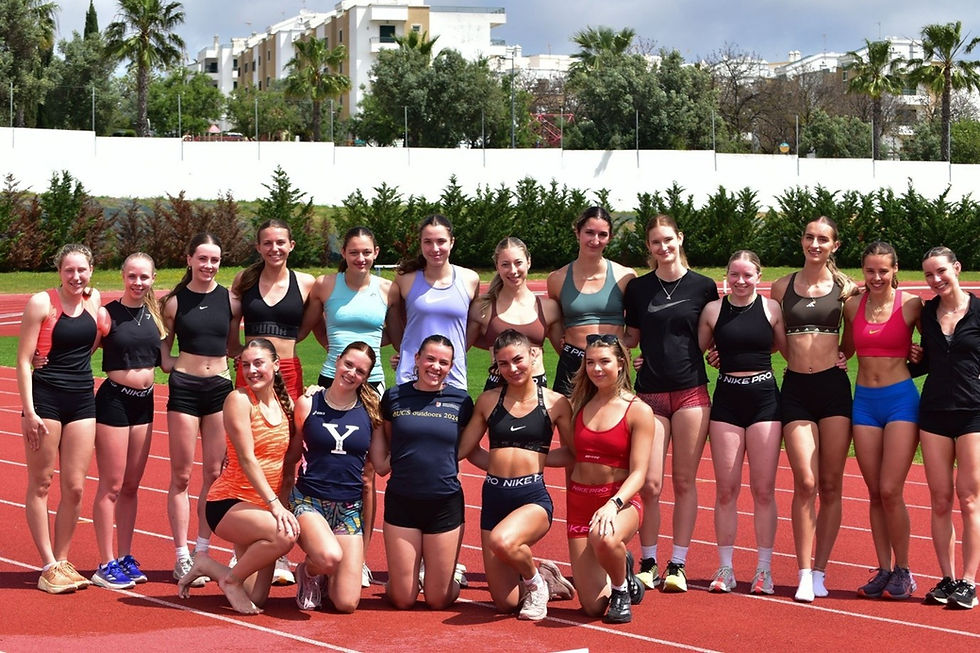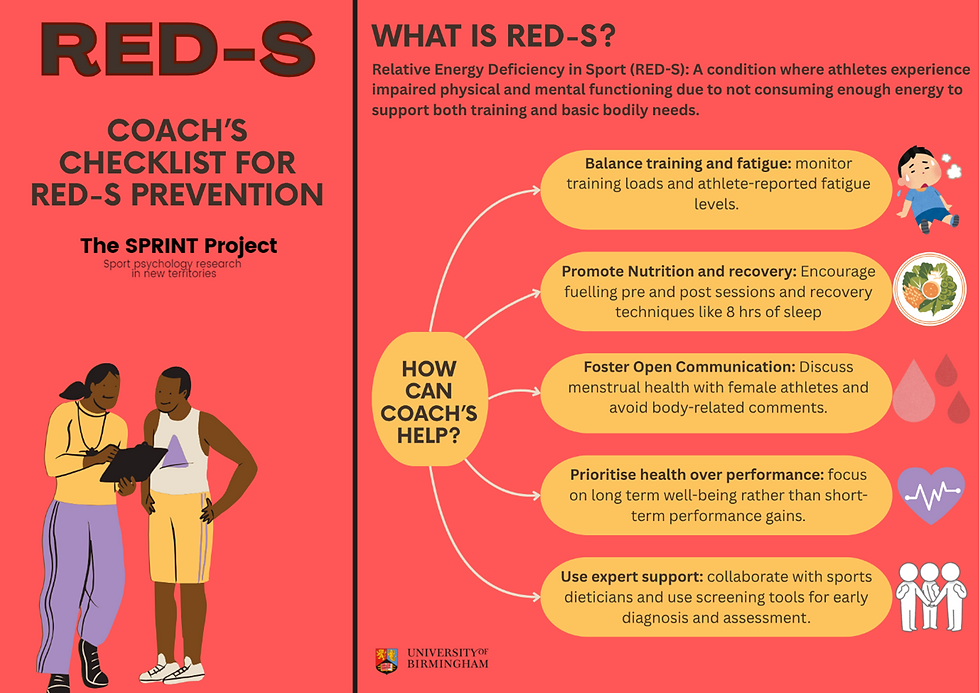Sprint Smarter: A Coach’s Guide to Tackling RED-S in Elite sprinters
- SPRINT project

- Aug 22
- 4 min read
In the pursuit of peak performance, athletes push their bodies to the limit. But when energy intake consistently falls short of training demands, the consequences can be devastating. Relative Energy Deficiency in Sport (RED-S) is a serious condition that disrupts nearly every physiological system, impairing performance, increasing injury risk, and jeopardising long-term health.
For coaches, recognizing the warning signs and addressing RED-S proactively is essential. It not just for safeguarding an athlete’s health, but for ensuring they can perform at their highest level. This blog will explore how to detect RED-S, the consequences it has on an athlete, and the key strategies coaches can implement to prevent its onset.
By fostering a training environment that prioritises proper nutrition, recovery, and well-being, coaches can play a pivotal role in helping their athletes thrive both in competition and in life.

What Is Red-S?
RED-S was first acknowledged by the International Olympic Committee (IOC) in 2014 and refers to the impaired physiological and psychological functioning athletes can experience when they are not getting enough energy to meet the demands of both training and basic bodily functions; a state known as low energy availability (LEA; Mountjoy et al., 2014). RED-S builds upon the earlier understanding of the Female Athlete Triad, which refers to the interrelationship between three key components: LEA, menstrual dysfunction, and reduced bone mineral density. Originally recognized as a condition affecting only female athletes, further research has shown that RED-S is a broader syndrome that impacts both males and females. Moreover, RED-S extends beyond the triad to include additional physiological impairments such as immune dysfunction, cardiovascular strain, and psychological consequences.
Who IS Affected by RED-S?
It's a common misconception that RED-S only affects endurance athletes or those in weight-class sports. In reality, it can affect any athlete who isn't fuelling enough for their training. One study by Sygo and colleagues (2017) found that 54% of elite female sprinters showed markers of LEA after just five months of training.
For sprinters who rely on power, speed, and recovery, RED-S can undermine performance and long-term health. It's not always intentional and factors like low appetite post-training, lack of nutrition knowledge, or prioritising 'clean eating,' are all risk factors. As a coach, understanding RED-S and who is at risk can make all the difference in keeping your athletes performing at their best.

Implications OF RED-S On Health And Performance
Problematic LEA can lead to:
Decreased resting metabolic rate, making it harder to maintain energy balance.
Impaired reproductive hormones leading to menstrual irregularities in females and reduced testosterone in males.
Reduced bone density
Compromised immune and cardiovascular health
Increased injury risk
Delayed recovery
Reduced psychological well-being
Gastrointestinal issues, including digestive discomfort, bloating and altered gut function.
What this means is that the body is not adequately fuelled to sustain the demands of training and bodily function so important systems in the body begin to downregulate to try and conserve energy. For sprinters who rely on maximum intensity and peak output this can significantly reduce sprint times, lead to inconsistent performance, and cause chronic fatigue all of which directly impact athletic performance.
Spot The Signs of RED-S In Sprinters
As a coach, you play a crucial role in safeguarding your athletes’ health and performance. Recognizing the early warning signs of RED-S can help prevent long-term health problems and ensure athletes receive the support they need. RED-S can manifest in subtle ways, often mistaken for normal training fatigue or dedication to sport. However, being aware of these key indicators can make all the difference
Weight loss
Restrictive eating
Low iron levels that presents as dizziness, tiredness, low energy and may also present due to heavy periods.
Recurrent injuries and illness
Decline in sprint times and quality of reps
Changes in mood such as increased irritability, anxiety or signs of depression
Feeling tired and flat all the time
Absence of consecutive menstrual cycles (amenorrhea)
Sleep disturbances
How Coaches Can Help Prevent RED-S

If you suspect an athlete may be experiencing RED-S, approach the situation with care and support. Encourage open conversations about nutrition, recovery, and well-being. Collaborate with dietitians, medical professionals, and mental health experts to ensure athletes receive the guidance they need. By fostering a culture of balanced training and proper fuelling, coaches can help prevent RED-S and promote long-term athletic success.
Conclusion
As a coach, you play an important role in supporting not just an athlete’s performance, but their overall health and well-being. Recognizing, addressing, and preventing RED-S starts with awareness and education. Coaches also have the power to shape an environment that not only enhances athletic performance but also safeguards long-term health creating a safe, supportive training environment in which athletes feel they can speak up about concerns and being able to recognise the early signs of LEA are the most effective ways to help prevent RED-S (Verhoef, S. J et al., 2021).
Written by Jasmine Wilkins
References
Mountjoy, M., Sundgot-Borgen, J., Burke, L., Carter, S., Constantini, N., Lebrun, C., ... & Ljungqvist, A. (2014). The IOC consensus statement: Beyond the female athlete triad-relative energy deficiency in sport (RED-S). British Journal of Sports Medicine, 48(7), 491-497. https://doi.org/10.1136/bjsports-2014-093502
Sygo, J., Coates, A. M., Sesbreno, E., Mountjoy, M. L., & Burr, J. F. (2018). Prevalence of indicators of low energy availability in elite female sprinters. International Journal of Sport Nutrition and Exercise Metabolism, 28(5), 490-496. https://doi.org/10.1123/ijsnem.2017-0397
Verhoef, S. J., Wielink, M. C., Achterberg, E. A., Bongers, M. Y., & Goossens, S. M. (2021). Absence of menstruation in female athletes: Why they do not seek help. BMC Sports Science, Medicine and Rehabilitation, 13, 1-11.https://doi.org/10.1186/s13102-021-00372-3



Comments